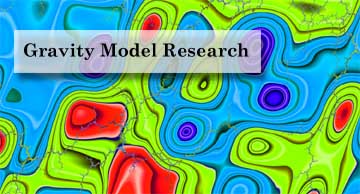
Introduction
The gravity field of the planet Earth can be measured and modeled through a variety of means. The discipline of Physical Geodesy combines knowledge that comes under the mathematical discipline of Potential Theory and the scientific discipline of Geophysics.
Elements of potential theory are applied to the diverse data of gravimetric geodesy (e.g., absolute gravity measurements, torsion balance observations, deflections of the vertical observations, satellite perturbation observations, satellite altimetry observations, gravity gradient observations, etc.) in attempts to solve, uniquely, boundary value problems associated with the shape of the Earth. These are not trivial problems and the theory involved enjoys high degrees of beauty, sophistication and abstraction. It is safe to say that to solve the problems of physical geodesy, one needs ample instruction in mathematics and theoretical mechanics.
Resources
Related information found on this site:
- The Concept of the Geoid
- Maps of the Geoid based on the EGM96 Model
- History of NASA Gravity Models
- Geoid Maps from Other Sources
- Map of US Bouguer Gravity Anomalies
- Gravity Anomalies and Maps of Gravity Anomalies
- Gravity Gradients and Maps of Gravity Gradients
Hard Copy
• Textbooks on the subject
- Bomford, G., Geodesy, 4th ed., Oxford Univ. Press, Oxford, 1980.
- Bursa, M. & J. Kostelecky, Space Geodesy and Space Geodynamics, Czech Ministry of Defence, Prague, 1999.
- Bursa, M. & K. Pec, Gravity Field and Dynamics of the Earth, Springer Verlag, Berlin, 1988.
- Caputo, M., The Gravity Field of the Earth, Academic Press, New York, 1967.
- Heiskanen, W. A. & H. Moritz, Physical Geodesy, Freeman, San Francisco, 1967.
- Heiskanen, W. A. & F. A. Vening-Meinesz, The Earth and its Gravity Field, McGraw Hill, New York, 1958.
- Heitz, S. & E. Stöcker-Meier, Grundlagen der Physikalischen Geodäsie, Dummler, Bonn, 1998.
- Helmert, F. R., Die Mathematischen und Physikalischen Theorieen der Höheren Geodäsie, 2 vols., Teubner, Leipzig, 1880 (reprinted by Minerva, Frankfurt am Main, 1962).
- Hopfner, F., Physikalische Geodäsie, Akademische Verlagsgesellschaft, Leipzig, 1933.
- Hotine, M., Mathematical Geodesy, ESSA Monograph 2, U.S. Dept. of Commerce, Washington, DC, 1969.
- Kaula, W. M., Theory of Satellite Geodesy, Blaisdell Publishing Co., Waltham, MA, 1966.
- Molodenskij, M. S., V. F. Eremeev & M. I. Yurkina, Methods for the Study of the External Gravitational Field and Figure of the Earth, Engl. trans., U.S. Dept. of Commerce, Washington, DC, 1960.
- Moritz, H., Advanced Physical Geodesy, Herbert Wichmann Verlag, Karlsruhe, 1980.
- Moritz, H., The Figure of the Earth, Herbert Wichmann Verlag, Karlsruhe, 1990.
- Moritz, H. & B. Hofmann-Wellenhof, Geometry, Relativity, Geodesy, Herbert Wichmann Verlag, Karlsruhe, 1993.
- Pick, M., J. Picha & V. Vysocil, Theory of the Earth's Gravity Field, Elsevier, Amsterdam, 1973.
- Torge, W., Geodesy, Walter de Gruyter, Amsterdam, 1980.
- Torge, W., Gravimetry, Walter de Gruyter, Amsterdam, 1988.
- Tsuboi, C., Gravity, George, Allen & Unwin, London, 1983.
- Vanicek, P. & E. Krakiwsky, Geodesy: The Concepts, 2nd ed., North-Holland, Amsterdam, 1986.
The classic text used by English speaking students of Gravimetry and Physical Geodesy is the one by Heiskanen and Moritz (see bibliography below) followed by the advanced text authored solely by Moritz. Another comprehensive work in the field is the one by Pick, Picha & Vysocil. The chapter contents contained in these works gives an orderly synopsis of the associated material:
|
Contents of Heiskanen & Moritz' Physical Geodesy
|
Contents of Pick et al., Theory of the Earth's Gravity Field
|
The chapter on Celestial Methods in Heiskanen & Moritz is more aptly covered by the subdiscipline of Satellite Geodesy. Obviously, Satellite Geodesy shares some overlap with the study of Planetary Dynamics. The classic Satellite Geodesy text in English is the one by Kaula. The contents of Kaula's text is given below:
|
Now again in print from Dover Publications
|
Other texts on Satellite Geodesy are found in other languages. Most notably are the recent texts by M. Schneider; Satellitengeodäsie and Volume IV of Schneider's series of Himmelsmechanik. Further information can be found on the planetary dynamics page.